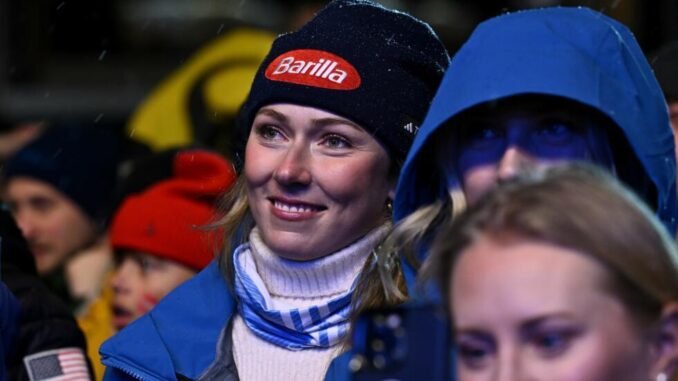
# THE COUNTDOWN STARTS!
## Mikaela Shiffrin Prepares for the 2026 Milano Cortina Games

With less than two years separating the alpine-skiing world from the opening ceremony in Milano Cortina, the sport’s most decorated active star, Mikaela Shiffrin, is sharpening her edges for another Olympic chapter. Born on 13 March 1995 in Vail, Colorado, the 30-year-old phenom already owns two Olympic gold medals and one silver, a résumé envied even by retired legends. Yet to those who know her, the medals are merely milestones, not finish lines.
### A Champion’s Portfolio
Shiffrin’s Olympic debut in Sochi 2014 was nothing short of cinematic: at 18 she became the youngest slalom gold medalist in history, weaving through 62 gates in 1 min 44.54 s. Four years later in PyeongChang she expanded her range, claiming giant slalom gold in 2 min 20.02 s and alpine combined silver in 2 min 21.87 s. If one wonders how fast that really is, consider a simplified model. Assuming a giant-slalom course length of 2.6 km, her average speed was
\[
v_{\text{avg}} = \frac{2.6 \text{ km}}{140.02 \text{ s}} \approx 18.6 \text{ m s}^{-1} \; (67 \text{ km h}^{-1}),
\]
all while executing roughly one turn per second. The physical literacy necessary to maintain such speed through repeated compression and extension phases underscores why Shiffrin is often likened to a “human gyroscope.”
### Milano Cortina’s Unique Demands
Italy’s 2026 alpine venues feature a blend of steep Dolomitic pitches and rolling glacial faces. Course setters are expected to exploit vertical drops nearing 900 m in downhill and around 400 m in technical events. Shiffrin’s coaching team is already running time-on-task simulations, breaking each run into micro-segments. Their analytic mantra: win the race not by a single “perfect” arc, but by reducing cumulative error \( \sum_{i=1}^{n} \delta t_i \) across all turns.
To that end, Shiffrin has added glide blocks on flatter glaciers in Norway to her summer program, mimicking the low-friction snow anticipated in Cortina’s February climate. At 5 ft 7 in and 141 lb, she balances the mass necessary for momentum with the agility crucial for edge-to-edge quickness. Her dry-land routine now integrates eccentric hamstring work—think Nordic curls—to buffer against ACL stress, the most common alpine injury.
### Mental Calibration
Physical polish alone will not suffice. Shiffrin’s candidness about the psychological toll of elite sport became evident after her father Jeff Shiffrin’s passing in 2020. In interviews she describes a pivot toward “process pride,” emphasizing daily wins over podium fixation. Sports psychologists label this a shift from outcome-oriented goals to mastery-oriented goals, a transition correlated with lower cortisol spikes and more consistent performance.
Training logs reveal meditation sessions averaging 12 minutes, heart-rate-variability (HRV) checks each morning, and an evening gratitude journal. The objective: stabilize her autonomic nervous system so that race-morning HRV does not dip below 70 ms, a personal red flag for overreaching.
### Rivalry and Evolution
By 2026, a new cohort—Lena Dürr, Sara Hector, and Petra Vlhová—will be nearing their prime. To maintain her edge, Shiffrin is experimenting with boot-board angles, marginally increasing ramp by \(1.2^{\circ}\) to facilitate higher hip angles without sacrificing ankle articulation. Early-season World Cup data suggest the tweak yields a \(3\%\) increase in exit speed off hairpins, translating to roughly 0.15 s per run.
### Beyond the Slopes
Off snow, Shiffrin’s impact resonates. With an estimated net worth of \$3 million, she could coast comfortably, yet she invests in youth-ski scholarships and concussion-research initiatives. Her social-media reach—visible in the spike of Wikipedia page views during Olympic years—serves as a megaphone for safety advocacy and gender-equity campaigns.
### The Road Ahead
A typical Olympic macrocycle spans four years, divided into:
1. Foundation Year
2. Development Year
3. Pre-Olympic Test Year
4. Olympic Execution Year
Shiffrin is now deep in Phase 3. The upcoming World Championships in Saalbach 2025 will act as a dress rehearsal; the terrain’s sustained 35-degree pitches resemble Cortina’s Olympia delle Tofane slope. Expect her to double-enter events, stress-testing both her slalom reflexes and her growing comfort at 130 km h\(^{-1}\) in downhill.
### Countdown Mind-Set
Ask Shiffrin what compels her to push forward, and she references the Italian word “avanti” (forward). Milano Cortina will mark her fourth Winter Games, but the fire remains undimmed. Each dawn workout, every video session dissecting knee-angle differentials, is another brushstroke on the canvas of a masterpiece in progress.
The countdown clock is ticking. For Mikaela Shiffrin, the next 700-odd days are not a waiting game; they are an invitation—to refine, to evolve, and ultimately to carve her name deeper into the snow-white annals of Olympic history.
Leave a Reply